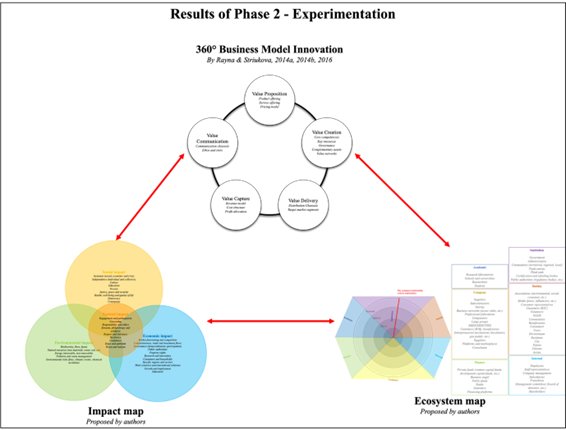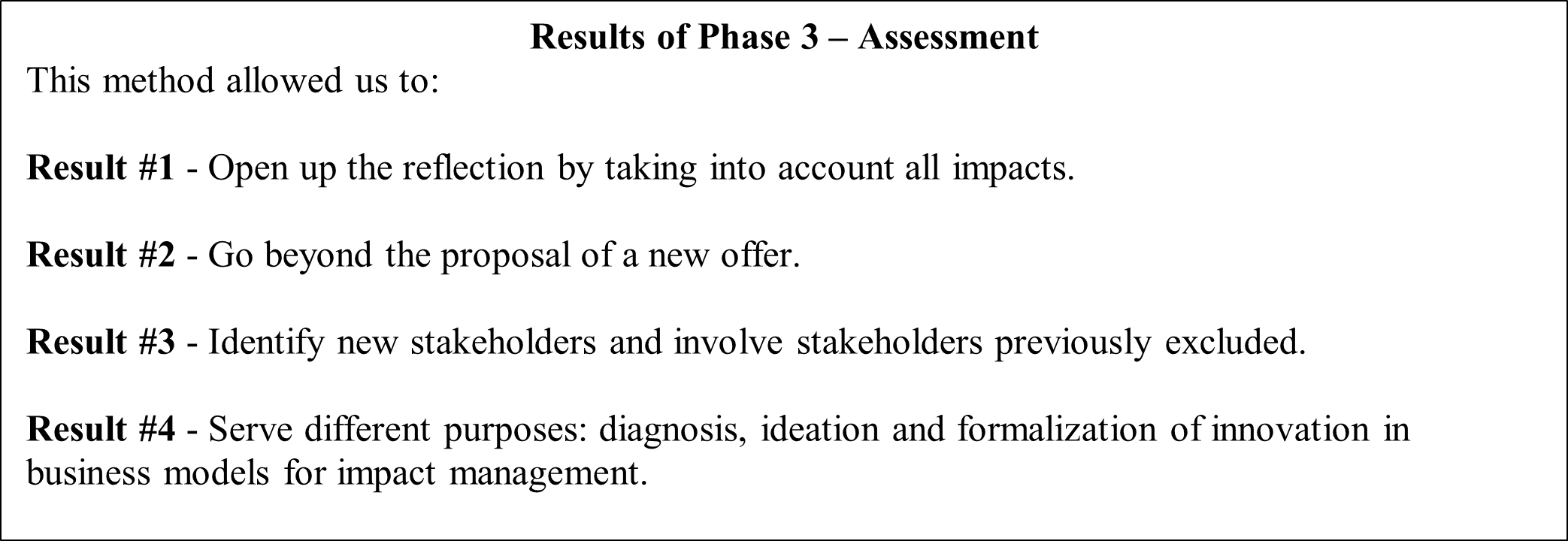Publié le 4 novembre 2022 – Mis à jour le 4 novembre 2022
Authors
Valentine Georgeta, Thierry Raynab
a Université Côte d'Azur, CNRS, UMR 7321 GREDEG, EUR ELMI, Nice, France
b Ecole Polytechnique, CNRS, i3-Centre de Recherche en Gestion, Paris, France
While there has been a growing awareness among businesses of the critical importance of business model innovation (alongside other more traditional forms of innovation), the critical challenges currently facing humanity (e.g. climate change, pandemics) and the strong desire for change among the younger generations (e.g. ‘Un manifeste pour un réveil écologique’) have led an increasing number of businesses to consider the question of their global impact and search for manners to reconcile economic performance and environmental (Carvalho et al., 2014; León et al., 2019) and social (Acosta et al., 2014; Carvalho et al., 2014) impact through business model innovation (Rangan et al., 2012).While the issue of business model innovation is very popular in the academic literature, so far few of these works have addressed the question of the relationship between business model innovation and socio-environmental impact. A further issue is that, while the literature provides numerous frameworks for business model innovation (e.g. Joyce & Paquin, 2016; Nosratabadi et al., 2019), the issue of impact has generally been addressed in a very partial and ad hoc manner (Goni et al., 2020). As a result, a comprehensive framework that encompasses all the dimensions of impact is lacking. In this research, we asked the following question: How can business model innovation combine economic performance and socio-environmental impact?
To answer this question, we conducted a research-action study (David et al., 2012), which followed three phases: (1) an exploration phase (Dumez, 2016), which explored the problems, (2) an experimentation phase, which proposed tools and a method to innovate the business model and take impact into account– and (3) an assessment phase to understand the implications for companies that use this methodology. To clarify the presentation of results, we propose to describe the different phases and methods in this order.
The first ‘exploration’ phase is based on 24 semi-structured interviews (Gavard-Perret et al., 2012) of large companies, start-ups, and investment funds – all positioned as having ‘impact’ as a core objective – and aims to investigate the relationship between business model innovation and the different forms of impact.
The first key finding is that while, in a comprehensive manner and as highlighted in the literature, impact has many different dimensions (i.e. economic, environmental, social and societal), impact-driven companies and funders tend to have a partial view of impact and to be partial to some specific dimensions (e.g. companies targeting environmental impact tend to neglect the social impact of their decisions). Furthermore, even for such enlightened companies, their view of impact appears to be heavily influenced by a) regulations and policies and b) measurable impacts (e.g. tons of carbon, number of jobs created).
The second finding of this exploratory research is that an extensive change in business model is required to ‘deliver impact’. Indeed, product/service innovation and market segmentation do not appear to do the trick. Instead, a business model innovation that includes impact management appears to mainly depend on the value creation and value capture components of the business model. Delivering impact is not so much about doing something different, but instead doing something very similar, but in a quite different manner, short of which even impact-driven companies may be accused of impact washing.
The third finding relates to the role of ecosystems. This research highlights that both internal and external stakeholders play a critical role in enabling companies to deliver impact. In this respect, ecosystem governance may well be the missing link between business model innovation and impact.
The last finding is related to the previous one, and it is the importance of governance bodies. They could have different names: ‘stakeholders committee’, ‘impact committee’, but they have the same goal: to initiate, develop, control and follow the integration of impact at the heart of the business model.

Figure 1 - The results of Phase 1: Exploration
Following these different observations, we have proposed a methodology based on three tools to innovate the business model in order to deliver impact. This is the second ‘experimentation’ phase.
To innovate the business model to include impact, companies must adopt a comprehensive definition and assessment of the concepts of impact, business model and ecosystem (see results of first phase). That is why we designed a methodology which allows an exhaustive approach of each concept and, at the same time, combines them. This method is based on three tools: a 360° Innovation Business Model (Rayna & Striukova, 2014b, 2014a, 2016) which is a pre-existing tool, an Impact Map and an Ecosystem Map.
This method has been tested as a managerial tool with three focus groups from three large companies (pharmaceutical, press and media, and energy provider).

Figure 2 – The results of phase 2: Experimentation. Innovation Business Model for Impact Method.
After testing the method with the focus groups, we interviewed different individuals to understand the implications for them and more broadly for companies of using this method; this is the third ‘assessment’ phase.
First, this method allowed the participants to broaden their perspective by taking into account other impacts. Generally, participants focused on one aspect - either environmental or social - of the impact. The use of this methodology allowed them to integrate new dimensions of impact into their thinking.
The second implication was to go beyond the proposal of a new offer. The 360° vision of the business model allowed them to question more strategic and internal dimensions of organisation. Furthermore, the question of the governance of these impacts emerged as an important issue for the participants.
Third, the method served to identify new stakeholders. Mapping of the ecosystem enabled the identification of new stakeholders who were initially excluded.
Finally, the concomitant use of the different tools served several purposes: diagnosis, ideation and formalisation. In all cases, the association of these different tools allowed us to create and define a method for integrating the notion of impact into the heart of the organisations' existing or non-existing business model.

Figure 3: The results of Phase 3: Assessment
This research examines how to innovate a business model to include impact. Through this research, we contribute to the theoretical literature on business model innovation for impact. Furthermore, this research offers several contributions for practitioners by proposing a concrete method.
Bibliography
- Acosta, P., Acquier, A., Carbone, V., Delbard, O., Fabbri, J., Gitiaux, F., Manceau, D., & Ronge, C. (2014).
- Les business models du développement durable. L’Expansion Management Review, 1, 20‑29.
- Carvalho, A., Mimoso, A. F., Mendes, A. N., & Matos, H. A. (2014). From a literature review to a framework for environmental process impact assessment index. Journal of Cleaner Production, 64, 36‑62.
- David, A., Hatchuel, A., & Laufer, R. (2012). Les nouvelles fondations des sciences de gestion : Éléments d’épistémologie de la recherche en management. Presses des MINES.
- Dumez, H. (2016). Méthodologie de la recherche qualitative : Les questions clés de la démarche compréhensive. Vuibert.
- Gavard-Perret, M.-L., Gotteland, D., Haon, C., & Jolibert, A. (2012). Méthodologie de la recherche en sciences de gestion (Pearson, Vol. 2).
- Goni, F. A., Chofreh, A. G., Orakani, Z. E., Klemeš, J. J., Davoudi, M., & Mardani, A. (2020). Sustainable business model : A review and framework development. Clean Technologies and Environmental Policy, 1‑9.
- Joyce, A., & Paquin, R. L. (2016). The triple layered business model canvas : A tool to design more sustainable business models. Journal of cleaner production, 135, 1474‑1486.
- León, T., Liern, V., & Pérez-Gladish, B. (2019). A multicriteria assessment model for countries’ degree of preparedness for successful impact investing. Management Decision.
- Nosratabadi, S., Mosavi, A., Shamshirband, S., Kazimieras Zavadskas, E., Rakotonirainy, A., & Chau, K.
- W. (2019). Sustainable business models : A review. Sustainability, 11(6), 1663.
- Rangan, K., Chase, L. A., & Karim, S. (2012). Why every company needs a CSR strategy and how to build it.
- Rayna, T., & Striukova, L. (2014a). ’Few to Many’ : Change of Business Model Paradigm in the Video Game Industry. Communications & Strategies, 94, 61‑81.
- Rayna, T., & Striukova, L. (2014b). The Impact of 3D Printing Technologies on Business Model Innovation. In Digital Enterprise Design & Management (P.-J. Benghozi, D. Krob, A. Lonjon, H. Panetto (Eds.), Vol. 1‑261, p. 119‑132).
- Rayna, T., & Striukova, L. (2016). 360° Business Model Innovation: Toward an Integrated View of Business Model Innovation: An integrated, value-based view of a business model can provide insight into potential areas for business model innovation. Research-Technology Management, 59(3), 21‑28.
















